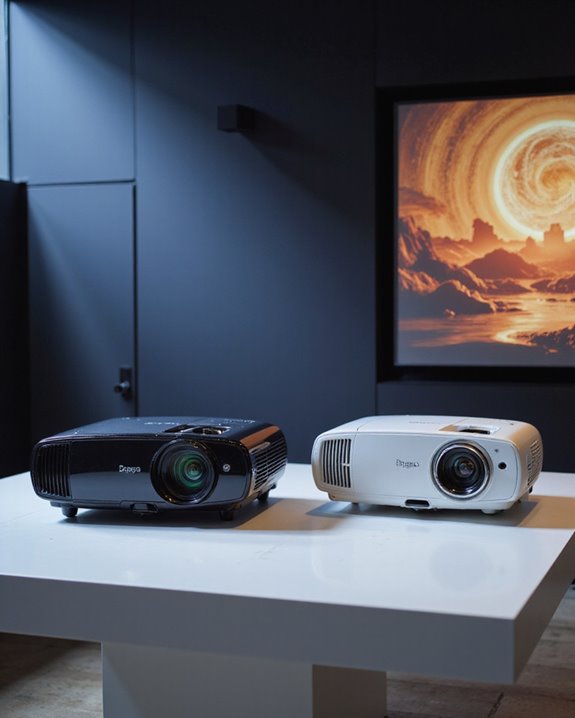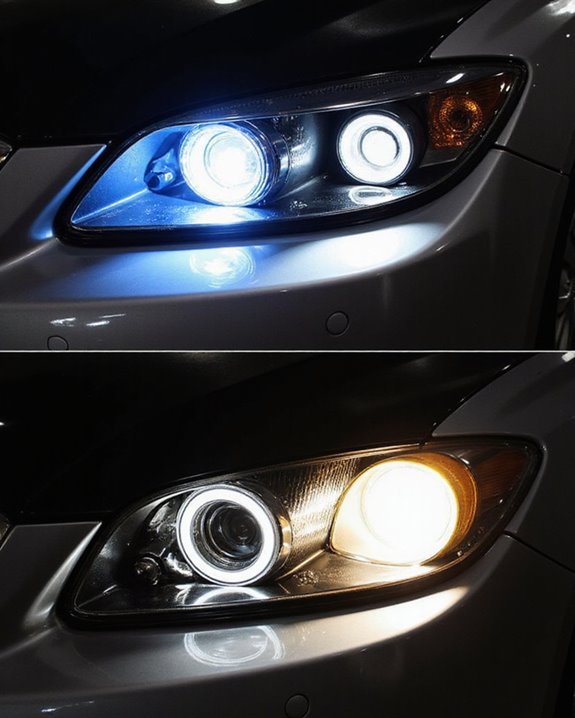LED and LCD projectors each excel in different scenarios. LED projectors offer superior portability, 20,000+ hours of lamp life, and lower maintenance costs, making them ideal for home theaters and travel. LCD projectors provide greater brightness (2,000+ lumens) and sharper images, perfect for well-lit business environments and detailed presentations. While LED projectors consume less power and require minimal upkeep, LCD models deliver enhanced color accuracy and professional-grade performance. The best choice depends on specific usage requirements and environmental conditions.
Key Takeaways
- LCD projectors offer superior brightness (2,000+ lumens) and are better for well-lit environments, while LED projectors work best in darker settings.
- LED projectors last 20,000-30,000 hours without lamp replacement, whereas LCD projectors need bulb changes every 4,000-6,000 hours.
- LED projectors consume up to 50% less power and require minimal maintenance, making them more cost-effective over time despite higher upfront costs.
- LCD projectors deliver better color accuracy and sharper images, making them ideal for business presentations and detailed graphics.
- LED projectors offer superior portability, durability, and resistance to environmental factors like dust and temperature changes.
Understanding LED and LCD Projector Technology
When comparing LED and LCD projector technologies, understanding their fundamental operating principles is essential for making an informed decision. LED projectors use light-emitting diodes as their primary light source, paired with digital micromirror devices that reflect light to create images. These projectors excel in color accuracy and offer superior portability features due to their compact design. LED projectors consume much less energy and offer up to 50% savings on power compared to traditional projectors.
LCD (Liquid Crystal Display) projectors operate differently, using three separate panels that filter light through tiny pixels. Each panel handles a specific color – red, green, or blue – to produce the final image. While LCD projectors can deliver high-resolution images, they typically require more space and maintenance than their LED counterparts. The LCD technology relies on traditional lamps that need periodic replacement, whereas LED light sources can last the entire lifetime of the projector.
The Battle of Brightness and Image Quality
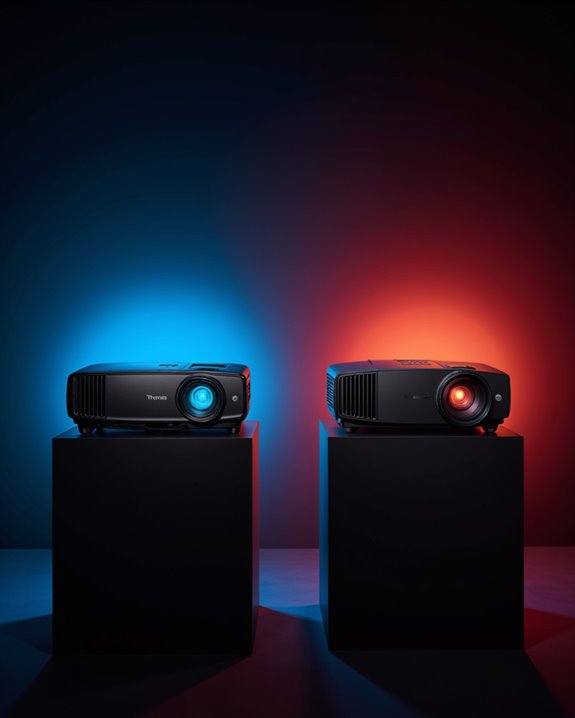
Although both LED and LCD projectors serve similar purposes, their capabilities differ markedly when it comes to brightness and image quality performance. LCD projectors excel in brightness, typically starting at 2,000 lumens compared to LED’s 200-500 lumens, making them better suited for well-lit environments. The higher brightness of LCD projectors also contributes to superior color accuracy and image vibrancy. For optimal viewing, screen size consideration becomes crucial when selecting between these technologies. Additionally, LCD projectors tend to have better contrast ratios, which enhance overall picture quality and depth. When comparing performance characteristics, key differences emerge:
- LCD projectors produce better black levels and maintain consistent colors across wider viewing angles
- LED projectors operate with lower noise levels due to simpler cooling requirements
- LCD models offer stronger contrast ratios, enhancing overall picture quality
- LED systems consume less power and provide longer lamp life, lasting up to 20,000 hours
These distinctions help users choose the right projector for their specific needs.
Comparing Cost of Purchase and Ownership
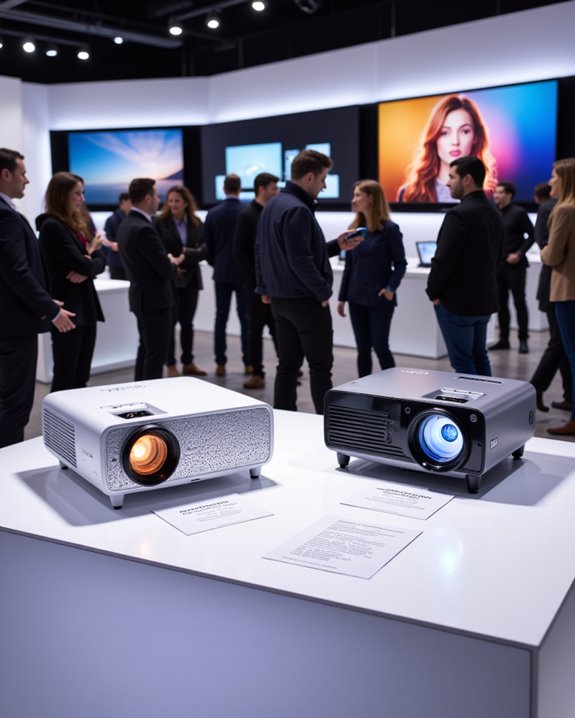
The cost of purchase and ownership between LED and LCD projectors reveals three distinct financial considerations: initial investment, ongoing expenses, and long-term value. A price comparison shows LCD projectors offer lower upfront costs, often hundreds of dollars less than LED models, making them initially more budget-friendly. Models like the Happrun H1 demonstrate LCD’s affordability, with quality options available for as low as $50. Additionally, LCD projectors typically have shorter lifespan light sources, which can lead to more frequent replacements and higher maintenance costs over time. However, long-term expenses favor LED technology. While LCD projectors require regular bulb replacements every 2,000-6,000 hours, LED light sources last 20,000-30,000 hours, dramatically reducing maintenance costs. LED projectors also consume less power, resulting in lower electricity bills. Even with warranty coverage considered, the total cost of ownership typically favors LED projectors due to their durability , minimal maintenance requirements, and energy efficiency, despite their higher initial investment.
Power Consumption and Environmental Impact
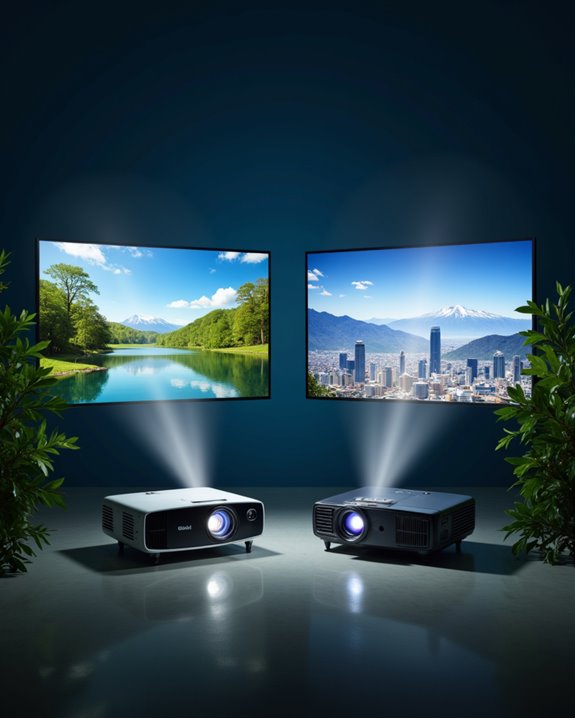
Modern LED projectors demonstrate significant advantages in power consumption and environmental sustainability compared to their LCD counterparts. While LCD projectors typically consume between 50 to 150 watts, LED models operate efficiently at 30 to 150 watts, resulting in notable energy savings over time. The advanced technology enables LED projectors to use up to 50% less energy than traditional models.
The eco impact of LED projectors extends beyond power consumption. Their longer lifespan means less frequent replacement, reducing electronic waste. Additionally, LED projectors require fewer resources during operation and generate a smaller carbon footprint. In brighter environments, both technologies may need more power, but LED projectors maintain better efficiency overall. Incorporating energy-efficient features can further maximize their environmental benefits.
Users can further optimize power consumption through:
- Adjusting brightness settings
- Using energy-saving modes
- Proper room placement
- Installing blackout curtains when possible
These practices enhance the environmental benefits of LED technology.
Durability and Maintenance Requirements
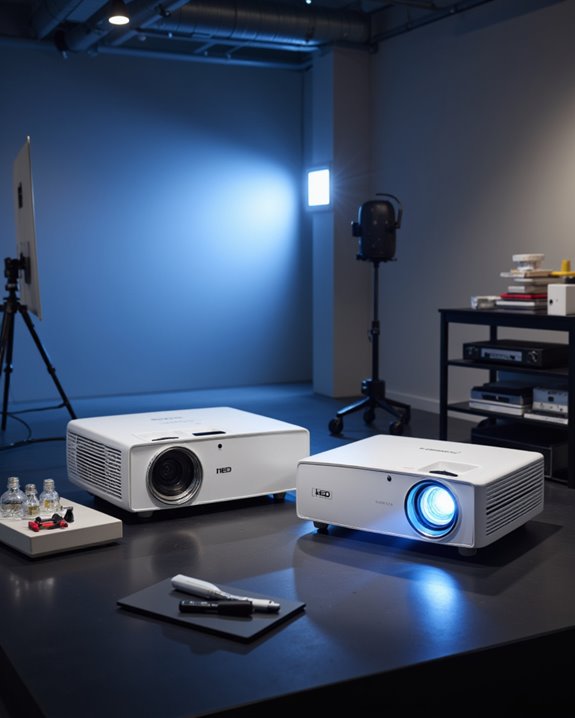
Durability represents a significant advantage for LED projectors when compared to LCD models, particularly regarding operational lifespan and maintenance requirements. Durability testing shows that LED projectors can last up to 30,000 hours, while LCD projectors typically need replacement after 4,000 to 6,000 hours of use. Less heat generation during operation also contributes to LED projectors’ extended longevity.
Maintenance tips for both types differ substantially:
- LED projectors require minimal upkeep, with no bulb replacements needed
- LCD projectors need regular lamp changes and more frequent cleaning
- LED systems are more resistant to dust, moisture, and temperature fluctuations
- LCD models often require complex cooling system maintenance
The superior durability of LED technology translates to lower long-term costs and fewer service interruptions. Their resistance to environmental factors like humidity and vibration makes them particularly suitable for permanent installations or frequent transportation.
Real-World Performance in Different Settings
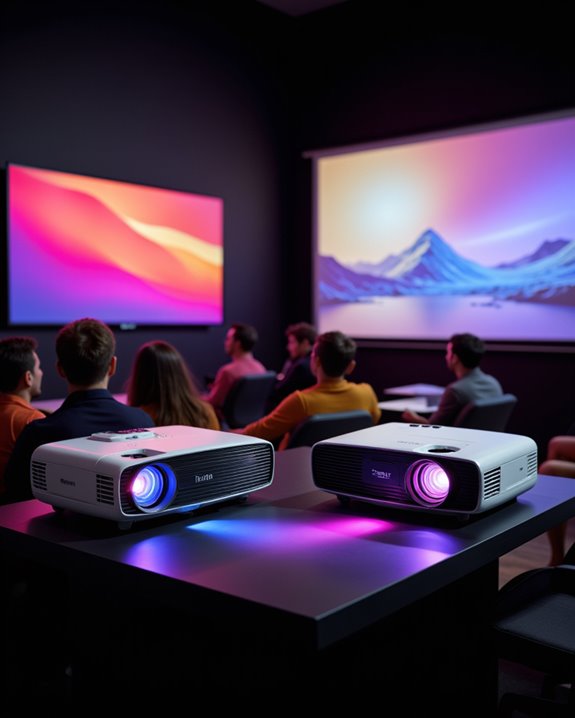
When comparing LED and LCD projectors across various environments, significant performance differences emerge based on specific usage scenarios and lighting conditions. LCD projectors excel in bright environments, making them ideal for offices, classrooms, and outdoor settings where ambient light is a challenge. Their higher brightness levels ensure clear visibility during daytime presentations. Regular filter maintenance checks are essential for LCD projectors to maintain optimal performance.
LED projectors stand out for their superior color accuracy and portability advantages, making them particularly suitable for home theaters and gaming setups. They are lighter, more energy-efficient, and require less maintenance than their LCD counterparts. In educational settings, both types offer distinct benefits – LCD projectors provide the necessary brightness for well-lit classrooms, while LED projectors offer easier setup and transport between rooms. The choice ultimately depends on the specific environment’s lighting conditions and intended use.
Making the Right Choice for Your Needs
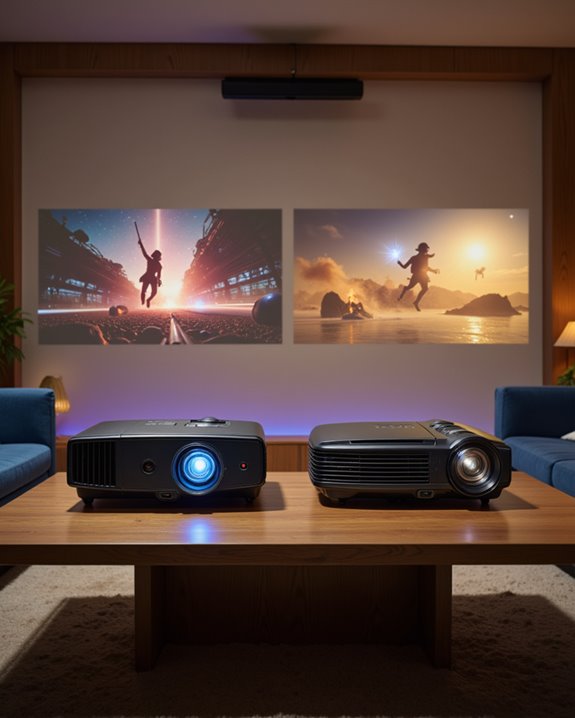
Selecting the ideal projector requires careful consideration of both immediate needs and long-term requirements. The choice between LED and LCD depends largely on specific use cases and environmental factors.
For business presentations where color accuracy is essential, LCD projectors offer superior performance in well-lit rooms and precise image reproduction. These projectors excel at displaying detailed graphics and text, making them ideal for office settings. Regular dust filter changes are necessary for optimal LCD projector performance.
LED projectors, with their enhanced portability features, serve well for those who need a travel-friendly solution. Their compact design, lower power consumption, and longer lifespan make them cost-effective for frequent users. They perform exceptionally well in home theater setups, delivering vibrant colors and better contrast in darker environments. The initial higher cost is often offset by reduced maintenance needs and extended operational life.
Latest Technological Advancements
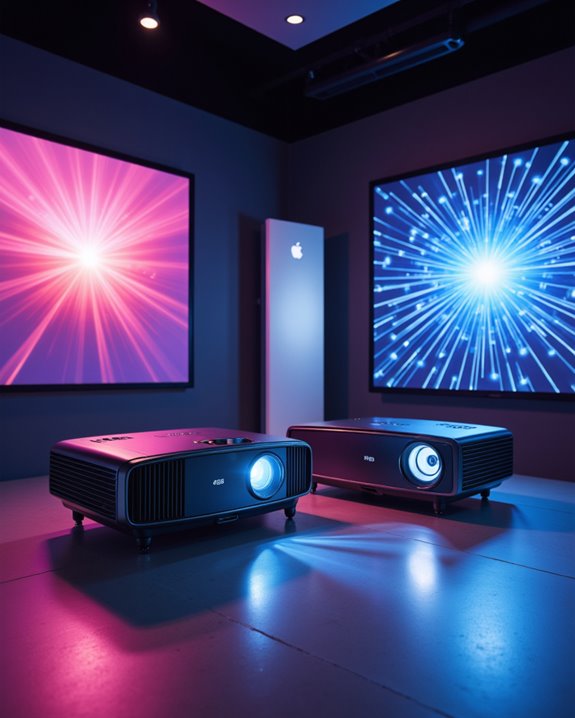
The landscape of projection technology has witnessed remarkable advancements in recent years, with both LED and LCD systems evolving to meet modern demands. Recent innovations include the development of Micro LED technology, which offers unprecedented pixel density and brightness levels, while maintaining energy efficiency.
LCD projectors continue to advance with improved resolution capabilities, now supporting 4K and 8K displays. The integration of Quantum Dot technology has enhanced color accuracy and brightness in newer models. Both technologies are seeing significant improvements in their core capabilities: LED projectors now boast lamp life spans of up to 30,000 hours, while LCD systems have achieved superior brightness levels suitable for well-lit environments. These advancements are complemented by the emergence of AI-driven features, which optimize performance and adjust settings automatically based on viewing conditions. Modern LED projectors have demonstrated impressive versatility in gaming applications, with models like the BenQ X3000i delivering 4K HDR gaming projection at 3000 ANSI lumens.
Professional Applications and Use Cases
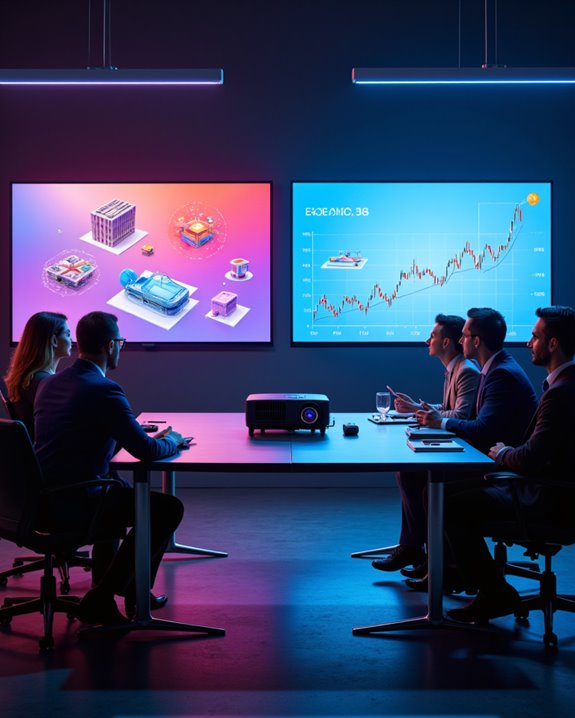
Professional environments demand distinct projection solutions based on their unique requirements and operational constraints. LCD projectors excel in brightly lit spaces like conference rooms and classrooms, offering high brightness levels and sharp image quality vital for detailed presentations. Their superior lens shifting capabilities make them ideal for permanent installations.
LED projectors provide notable portability advantages due to their compact size and lighter weight, making them suitable for professionals who travel or need quick setup options. Their excellent color accuracy and wider color spectrum make them particularly valuable in creative industries and multimedia production. Additionally, LED projectors’ durability and minimal maintenance requirements benefit high-usage commercial settings where consistent performance is essential. LED technology ensures minimal energy consumption compared to traditional display options, making it a cost-effective choice for long-term operation. Their sealed design and resistance to harsh conditions make them ideal for outdoor events or challenging environments.
Frequently Asked Questions
Can LED or LCD Projectors Be Used Outdoors for Backyard Movie Nights?
Projectors can be used outdoors for backyard movies, with LED models offering superior outdoor durability and weather resistance. Proper protection from elements is recommended, and both types perform best after sunset with minimal ambient light.
Do Gaming Consoles Work Better With LED or LCD Projectors?
Gaming consoles perform well with both technologies. LCD projectors offer superior brightness and resolution quality, while LED projectors can provide better latency performance. The choice depends primarily on gaming environment and specific console requirements.
Which Projector Type Is Safer for Children’s Eyes During Extended Viewing?
Both LED and LCD projectors offer comparable eye safety through indirect light projection. For viewing comfort during extended sessions, either type is suitable when properly configured with appropriate brightness and viewing distance settings.
Can These Projectors Work Effectively in High-Altitude or Extreme Temperature Conditions?
LED projectors demonstrate superior thermal performance and altitude adaptation capabilities. Their efficient heat management and dedicated high-altitude modes guarantee reliable operation in extreme conditions, while LCD projectors may face cooling challenges at higher elevations.
Are LED and LCD Projectors Compatible With Wireless Screen Mirroring Technologies?
Both LED and LCD projectors offer wireless compatibility for screen mirroring. They support technologies like Miracast, Chromecast, and AirPlay, enabling users to connect their devices seamlessly when both support matching mirroring protocols.

